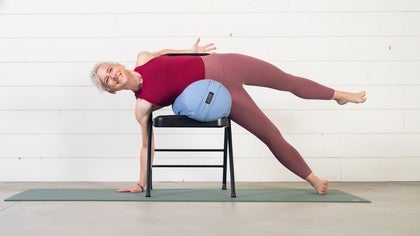
Moving Beyond the Binary: The Magnificent Process of Healing Ourselves
I inadvertently got stuck in a long bathroom cue to the men’s room at an event. I say I got stuck because I’ve only been using the men’s room for about a year (and not without trepidation). The guy behind me exclaimed loudly at my back,
“The women’s line is over there.”
Before we go any further, I should offer you some context: I am a genderqueer trans masculine forty four year old, and though my facial hair has grown in some and I have a male contoured chest, people still misgender me about half of the time. Something that, beyond being painful every single time it happens, can become extremely dangerous quickly, depending on the situation. I am also short for a guy, at 5’6". So I guess you could say I remain in a bit of an in-between state, which is nothing new for me, but is something most people have very strong reactions to.
I should also say that in this particular instance I was far away from home and had been invited to something way out of my element - an event that was very male dominated in an extremely conservative state - that already felt just short of dangerous for someone like me. I obviously had no idea I would feel this way until I found myself in the situation. That’s how these things go: you never imagine they will be that bad until they are.
With no other choice at this point, I turned to face him directly, masked, and stated in my lowest register flatly, “I’m a guy.”
Recognizing my voice as male, he said mortified. “Oh my gosh, I’m so sorry. Wow. That happens to my boys all the time because of their long hair. Ugh, I am so embarrassed.”
As I turned away without saying anything, he added,
“I guess I was blindsided by trying to pee,” and laughed lightly.
They guy was nice enough and apologetic. And I could see that he truly felt horrible. He was about my age and didn’t seem to hate me. In fact, I don’t even think he knew I was anything other than what I stated. I think his mind made quick, unexamined decisions that I was a woman due to my height and long hair, and when I turned around he realized I wasn’t. In his mind, his mistake had been misgendering a guy. He literally could’ve been someone in any one of my yoga classes. A well-meaning, ‘woke-ish’, modern man.
I proceeded into the men’s room where the stalls were taken up by guys peeing because the urinals were all full. Already feeling strained from having stood my ground and with the ever-present fear that he would come to a different conclusion, I waited, and lunged urgently at the first empty stall. I did my business and got out of there.
When delving into binaries, first, it’s useful to define the term:
—Binary: adj. relating to, composed of, or involving two things
n. something having two parts
When I looked up the actual definition of the word I was surprised. In my mind, it described two opposites by the impossibility of their coexisting or coming together. But I come to find that embedded in the definition is that the two things, energies, forces are part of a whole. More than implied, the wholeness is the baseline from which the definition is understood. Which lands directly at the heart of my proposal in this article: that understanding our relationship to binaries is a way to heal ourselves, and at its core, a journey toward our own wholeness. A journey that not only can we all engage with, but one we must take if we desire moksha - freedom.
Yoga has taught me that even the most extreme of dichotomies can be held simultaneously. And that the clearest expression and experience of our own humanity manifests when we can indeed sit with complexity and opposition, allowing them to coexist. They do not tear the mind, heart, or body apart, but rather grow it and offer it fuller dimensionality and scope when alive within us.
Still, both the feeling that this is true as well as the experience of holding two seemingly opposing forces at once often feels like an advanced practice, in that it is somewhat impossible, a riddle, or koan. Not advanced in the way that putting our foot behind our head is advanced, which may be specifically contingent on how our body fits with itself, our strength, elasticity, mobility, health of our joints, and other factors, but advanced rather in the acuity, energetic focus, willingness of the heart, and rigor required in the actuality of the holding. The challenge of inhabiting extreme tensions.
In asana - the physical practice of yoga - we first learn to recognize and mine bipolarity, the feeling of having two contrasting poles or charges. Aka, my foot is moving away from my head— opposition. This manifests lightness in the body and engages us in the ever so nuanced conversation that is balance.
As we grow more refined in our physical practice, we are then able to not only sense the presence of bipolarity, but we become also able to feel a simultaneous, exquisite di-polarity - poles drawing toward one another even as they draw apart. Things continue to gain more complexity as our experimenting further shows us that we can pulse between the two depending on the demands of our practice, as well as hold them singularly or together.
What we are experiencing then, are the fifth and sixth limbs of yoga in action: dharana, setting the mind on a specific point, and dhyana, a soft, wide focus that encompasses the whole.
This ability evolves into being able to turn all our senses inward — the seventh limb, pratyahara — and as the landscape of our inner world becomes less uncharted, we are able to not only hold the poles in our awareness, but pin other spaces along the way, like the pins in a map, and work these together or apart while still having an experience of whole. This happens not only on the physical plane, but we also gain dexterity in sensing it through other, subtler layers of the body.
While studying the eight limbs, we may perceive them as a ladder. As we achieve one we climb onto the next rung. But in fact, though there is an intentional order that naturally syphons into the next limb, ultimately, they are lived simultaneously.
This sets the groundwork for the eighth limb, samadhi — the perceived goal of our yoga practice — which is sometimes translated as "oneness", though this is not accurate because it implies an otherness and thus still lives within a binary. Pure awareness, on the other hand, a better translation, moves us beyond the binary, and out of structure altogether, to include, well...everything, excluding nothing. It is the sense that we are the drop and the ocean at the same time.
In this way, addressing our relationship to binaries, whether it is male/female, good/bad, us/them, lies not only at the heart of the experience of yoga, but is also one of the clear avenues toward its ultimate purpose: our own liberation.
As someone who identifies as transmasculine (transgender, with a masculine twist) non-binary (not identifying with male or female binaries), when people have a hard time wrapping their minds around my situation, the most common thing they say is “I don’t understand.” That is ok. The good news is that you don’t have to understand me to respect me or love me. They are not mutually exclusive. Not understanding is not a good enough reason to penalize, hurt, or marginalize someone, even though it is often used as such. Our hearts are big and ancient and can hold all of it without exploding.
It may feel sometimes like the existence and insistence for human rights by the transgender and non-binary community are a threat to the structures in place. But they are only a threat in that they aim to open, enlarge and bring elasticity to the inflexible structures hardened by our cultures through time. Well-meaning allies often ask “How can I help you?” The better question is “How can I heal myself?” These binaries are not just considerations for me or something I have to navigate, they are deeply hurting all of us.
The not necessarily ill-intentioned assumption the man made about me in the bathroom line - that I, a grown up, was in any way confused about the bathroom cue or signage - was not harmless. And though he may have been well-meaning, his words were not. I believe he didn’t mean anything horrible by it, but the product of our structures and indoctrination spoke volumes through him, and at its genesis, the assumption was inherently at the very least condescending if not entirely violent. Because he was either vying to be right and put me in my place - the end goal, ultimately to get me out of the way so that he might have his needs met - or he was assuming I was a complete idiot - a patronizing display of toxic masculinity, meant to belittle me out of the way. Either way, his behavior and actions, though not meant poorly, were controlling and an exertion of dominance. The excuse being that he needed to pee. Guess what? We all need to pee, Sir. We all need to pee.
Had the man examined his words before speaking, he would’ve realized that I probably was suited with a brain of some kind and none of it was worth the mention. He would have his needs met, as all men have before him, though he may have to wait a minute longer. And he wouldn’t have passed down the hurt that clearly has harmed even his own children.
A good teacher asks us to examine our blind spots. And yoga is the most excellent of teachers. When we are brave enough to see how we participate in promulgating these structures that are harming all of us, not just the trans and non-binary community, but our boys/ men/ girls and women everywhere, we start to clearly see that it is also these same structures that are harming our ability to heal the injustices and horrors that we have through time inflicted on others due to race. The need for "power over" is well encoded in our societal DNA. That is why we must all engage in this kind of active inquiry to change. For the good of our society and the world.
So what can we do to freshen, deconstruct, and reimagine our systems to offer more equanimity and intersectionality? In meditation we begin to grapple with our outlook not being so much between right and wrong but rather how we move toward less suffering. Observing and questioning binaries and their hold on us all is one such way to move in that direction.
Join Miles in his brand new show, Beyond Binary, a collection of talks and practices designed to uplift and celebrate the queer, trans, and nonbinary experience.
Comments
You need to be a subscriber to post a comment.
Please Log In or Create an Account to start your free trial.















